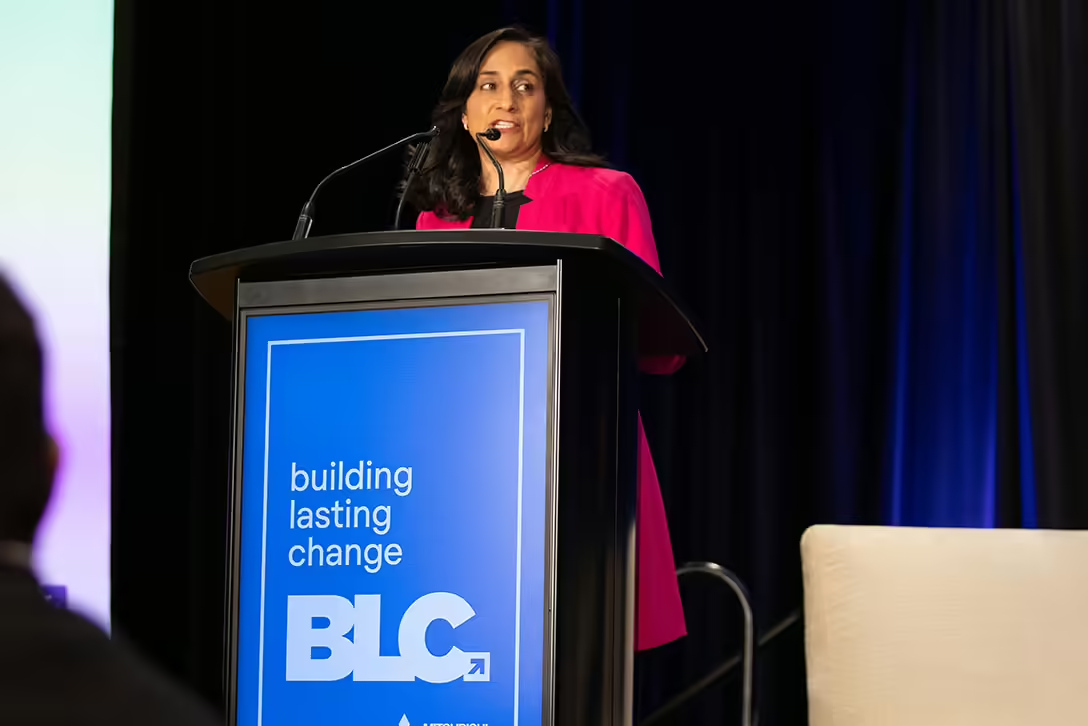Updates to the Greening Government Strategy at BLC
- Theme
- Advocacy
One of the highlights of Building Lasting Change (BLC) was the participation of the Honourable Anita Anand, President of the Treasury Board of Canada. Minister Anand leveraged the BLC opening keynote to share recent updates to the federal government’s efforts to green its operations, with a special focus on buildings.
The federal government (departments, agencies and crown corporations) is Canada’s largest real property owner, with a portfolio that encompasses 34,000 buildings. It also wields the greatest procurement power, making it ideally suited to create transformational change in the market.

That’s what makes the Greening Government Strategy so critical to the building sector’s low-carbon transformation and Canada’s shift to a low-carbon economy. The Strategy puts the government juggernaut on a path to decarbonization by requiring it to reduce greenhouse gas (GHG) emissions and increase the resilience of its assets by adapting them to the changing climate. Under the Strategy, Scope 1 and 2 emissions will be reduced by 40 percent by 2025 and by at least 90 percent below 2005 levels by 2050.
Some of key measures from the Strategy:
- All new buildings must be net zero operational emissions and have a reduction of 30% of embodied carbon and a climate change risk assessment.
- All major retrofits must go through GHG reduction life cycle cost analysis and determine a path to net-zero.
- Starting in 2025, all lease transactions will request and prioritize net-zero-emissions space. The Greening Government Strategy also supports Canada’s sustainability goals under the Paris Agreement, and other national and international commitments, with the aim to have all Government of Canada operations net zero by 2050.
At BLC, Minister Anand shared new enhancements to the Strategy, including broadening its scope to include Crown corporations, and strengthening commitments for greening the government’s real property.
“By enhancing the Greening Government Strategy, we are making our government operations cleaner and leading by example to drive change across all sectors of activity in Canada, stimulate activity in the clean tech sector, and contribute to Canada’s domestic and international commitments,” Anand said. “We have set data-driven targets to reduce emissions and protect our environment, and our actions demonstrate our determination to meet them.”
Recently, the government also updated their backgrounder on Greening Real Property, which demonstrates how it is advancing on the Strategy and its commitments. It also highlights examples of projects that have achieved net zero or net zero ready, including those either certified or pursuing certification under CAGBC’s Zero Carbon Building Standards and LEED.
“The updated Greening Government Strategy is one of the most ambitious government policies designed to decarbonize public buildings at scale,” said Thomas Mueller, CAGBC President and CEO. “The added focus on procuring low-carbon construction materials, prioritizing climate resiliency and reducing carbon emissions from leased federal properties will drive adoption and derisk new zero-carbon buildings for the industry. The inclusion of Crown corporations to align their operations with the strategy will create more market demand for low-carbon solutions.”
CAGBC was also pleased to have MP Julie Dabrusin, Parliamentary Secretary to the Minister of Environment and Climate Change and to the Minister of Energy and Natural Resources at BLC, where she introduced a session on unlocking sustainable value. During the session, Efficiency Capital, one of Canada’s first Energy-as-a-Service (EaaS) companies, announced it had secured a $50M investment from the Canada Infrastructure Bank (CIB) to help support small and medium-sized businesses across Canada decarbonize their buildings.
